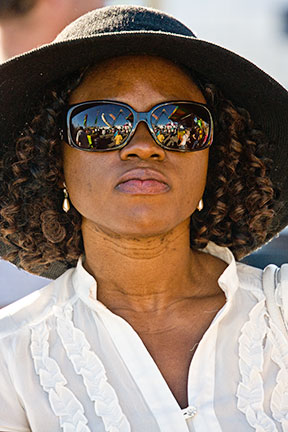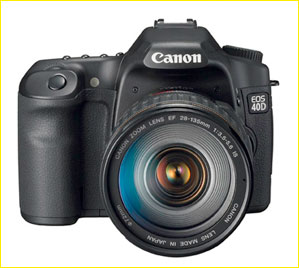
The photographs used on this page were all taken during a 3 hour period
at the Midway of The Canadian National Exhibition in Toronto.
They are not intended to illustrate any particular feature or capability of the 40D.
Though I shot with several different lenses, it just turned out that the
photographs shown on this page were all taken with the 70-300 DO,
one of my favourite lenses for this type of shooting.
Released in early September, 2007, just a few weeks after introduction, the Canon 40D is nominally Canon’s fifth generation (D30, D60, 10D, 20D, 30D) prosumer DSLR. In truth though, in some cases, such as between the 20D to 30D, there was little to be seen in terms of either features or performance improvements other thannicer floor mats and dual headlights.
The 40D is another matter. More than three years after the 20D’s introduction Canon has taken a major step forward and has brought to market a camera that though it is very much in the traditional mold, is almost completely new in terms of features. Performance in a number of areas is also significantly enhanced.
________________________________________________________________
The Differences
A look at the specs shows that the first noticeable difference is the chip resolution. The 40D is 10 MP while the 30D and 20D before it were 8 MP. At least the 40D now has the same resolution as the lower-end 400D (XTi).UPDATE:I mistakenly omitted the 400D from my original mention when this was first published. Mea culpa.
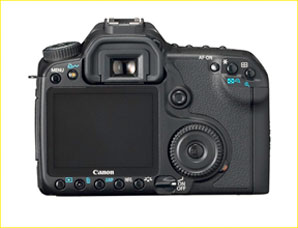
The Screen
The next difference of note is the rear panel of the camera. The new 3 inch screen is bright and as easy to read in bright daylight as any I’ve seen. The extra real estate is put to good use, with the camera now able to display an RGB histogram as well as a luminance histogram simultaneously.
The Viewfinder
The viewfinder is very good; as good as it gets on a reduced frame camera and a definite step up in apparent size and brightness over the 20D and 30D. For really great viewfinder brightness and size though you have to move up to the full-frame 5D. I was pleased to note that the 40D now has the ISO visible in the viewfinder, and it remains visible during setting. Nice. (It’s also continuously visible on the top LCD panel).

Mom and Two Kids – Toronto, September 2007
Canon 40D with 70-300mm DO lens @ ISO 400
Auto ISO
Auto ISO is available (finally), though I found it not as well implemented as it is on Nikon cameras. Canon seems to have almost grudgingly included it. The range of ISO sensitivity that is allowed in Auto mode varies depending on the shooting mode. Why can’t the camera simply allow a user settable range?
No MLU
And, just to piss us off once again, Canon still refuses to build in a one button, easily accessible mirror lock up capability. I’m convinced that they continue to resist doing so simply out of spite, since the rest of the industry sees fit to provide this as a normal function, and has for years. Canon even has that almost vestigial Direct Print button that only nine people in the entire world use, and which could easily be made into a MLU control with a simple Custom Function setting. Maybe next time.
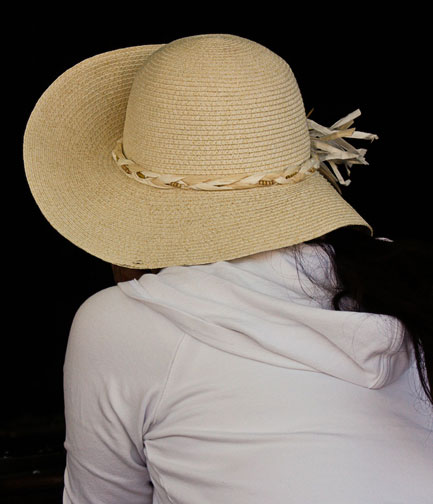
Straw Hat – Toronto, September 2007
Canon 40D with 70-300mm DO lens @ ISO 400
It needs to be noted though that some people regard setting Live View with the SET button as a form of MLU. We’ll, yes, in a way. But I’m not happy with it. For one thing, there’s the small matter of battery drain and sensor heating. One of the dirty little secrets of Live View is that it makes the sensor hot, and heat is the enemy of sensor noise. Secondly, it requires that you have the camera set up for Live View, which can be as many button presses as getting to MLU in the custom functions. Once there it does the job, but really, why can’t Canon give us a proper MLU button?It’s just firmware!
For the sake of full disclosure, one can also set the Mirror Lock-Up custom function to My Menu, which makes it quite accessible. So, are my complaints now no longer valid? Maybe, but I like bitching about it in the same way that Canon stubbornly refuses to give it a dedicated button, or at least build it into self-timer mode. And I’ll conrtinue to do so until they do.
My Menu and Custom Settings
Slowly but surely, with each new camera generation Canon improves function acceptability. The 40D now has three (count them – 3) custom settings on the Mode dial which allows you to set different combinations of just about every camera setting for greater acceptability. Very handy.
Also, there is a My Menu function which allows creating a custom menu on the rear LCD containing any five menu functions. Again, nicely done and very convenient.
6.5 FPS
The big news for many will be the high speed shooting capability of the 40D; 6.5 FPS with a claimed 75 frame JPG buffer, and a 17 frame buffer for raw files.
I timed 22 raw frames in 4 seconds before the buffer started to unload and slow down a bit. In Large Fine JPG I was able to shoot 100 consecutive frames in 17 seconds before hitting the buffer and the camera starting to slow down. The card used was a 4GB Sandisk Extreme IV.
This is exceptional performance, and sports and wildlife photographers will likely flock to this camera because of its high speed capabilities.
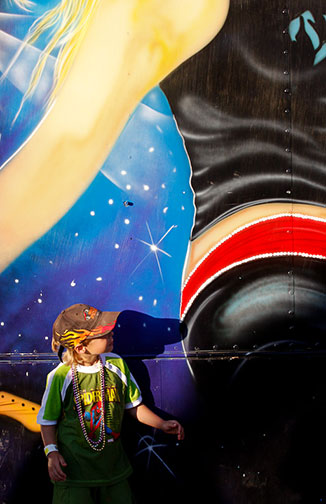
Growing Up – Toronto, September, 2007
Canon 40D with 70-300mm DO lens @ ISO 400
Battery
The same battery as many previous generation Canon DSLRs is used. A new, freshly charged battery was used at the Fairground, and at the end of the day I had shot 650 frames, and the battery indicator showed one bar remaining. I would guess useful battery life at about 750 – 800 frames with temperatures in the mid-20’s C (mid-70’s F). And this was with IS lenses, which do cause greater battery drain, so close to a thousand frames with non IS lenses is not unreasonable to expect. Lower temperatures will of course lead to fewer shots.
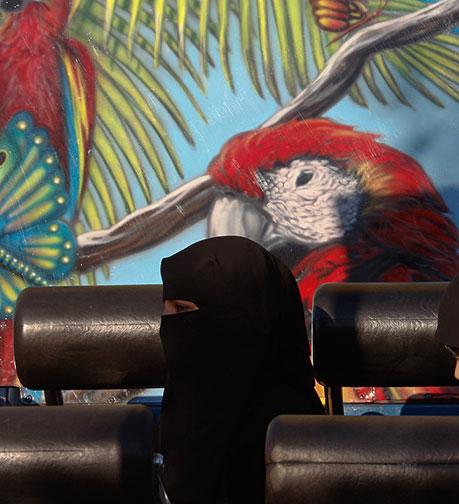
Rider and Parrot – Toronto, September 2007
Canon 40D with 70-300mm DO lens @ ISO 400
sRAW
Canon has introduced a compressed raw format called sRAW, which produces a file that’s only about 25% the size of a full raw file. I did not have the time to do any testing of what the pros and cons of this new format might be. Some companies, such as Phase One, have offered compressed raw files on their medium format backs for some time, and photographers who use them claim that very little is given up, and when disk space is running short on a shoot smaller raw files can be a real plus.
Live View

Angel – Toronto, September, 2007
Canon 40D with 70-300mm DO lens @ ISO 400
By this point Live View has started to become a standard feature on new DSLRs. Whether or not it is of use to any particular photographer will very much depend on ones personal style of working. For some it will be as welcome as the second coming, while for others it’s a big yawn.
I fall somewhere in between. I can see situations where it is handy to have, but in its current implementation Canon misses the mark somewhat. It least for me. Here’s what it’s all about.
Live View on a DSLR allows you to view what the camera will shoot on the rear LCD screen. Why would you look at "TV" when you can see the real thing through the viewfinder? One reason is to judge what the sensor will do to the subjects tonalities and colours. And since on the 40D there is a live histogram one can expose in the most appropriate manner, either normally when shooting JPG, or in raw with the histogram biased toward highlights while still avoiding burnout.
I found the live RGB histogram to be very accurate during Live View. Taking a shot and the reviewing it with flashing highlight indicator, and then later in DPP and Photoshop, showed that a careful setting, with the highlights just touching the right of the histogram, produced optimum raw files. (Note though that the live histogram is not accurate in low light conditions).
Another thing that I liked, which I has seen before in the 1D MKIII, is the silent shooting mode, where the shutter is released when the release is pressed, but isn’t recocked until you release pressure the shutter button. Initial release is almost silent, and so this means that in a quiet environment stealthy shooting is possible.
What I don’t care for in Canon’s current Live View implementation is that autofocus is not available. The camera can be set so that the the top-rear AF-On button lowers the mirror and activates AF for an instant, but otherwise one has to manual focus. This may not be an issue when doing landscape style shooting, but for action photography it is an issue. Manual focusing is made easier though by the ability to greatly magnify the image on screen.
Since Nikon’s D300 is said to have contrast detection autofocus available during Live View this may also turn out to be a competitive disadvantage for Canon.
The final issue I have with Live View is that the rear LCD isn’t articulated. (Neither do most cameras with Live View – yet). The lack of a flexible LCD makes using this feature less than ideal. As Live View technology matures I’m sure that we will see future DSLRs with articulated screens, and indeed some will start to come to market in the second half of this year.
Weather Sealing
The 40D claims improved weather sealing over the 30D, particularly around the card and battery doors. Also if the card door is opened while the camera is still recording data to the card, a warning appears, but the writing continues, unlike in the past when all buffered frames would be lost.
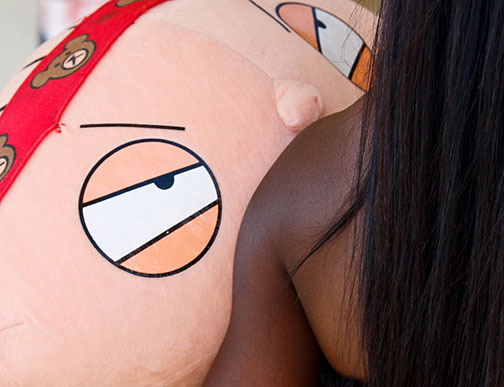
The Cold Shoulder – Toronto, September, 2007
Canon 40D with 70-300mm DO lens @ ISO 400
Sensor Cleaning
Like most new cameras, the 40D has an ultrasonic cleaning system that shakes the sensor’s cover plate to remove dust. This is activated each time the camera is turned on or off, or it can be done manually. There is also a dust mapping function which can be used to remove dust from images in post processing, but on raw files and only with DPP software.
Focusing System
The camera has the same 9 point autofocus system as the predecessor 30D and 20D, though now the sensors are all of the cross-type. Canon claims this provides 30% faster autofocus over the 20D. During my shooting I found the autofocus to be accurate and fast and better able to lock onto and hold moving subjects that the previous models, especially in dim conditions and with slower lenses.
14 Bit
The new buzz in DSLRs is the use of a 14 bit A/D converter. In theory this provides a fourfold increase in the number of colour and luminance values available, which should translate into smoother tonalities with less discontinuities, especially when extreme editing is done to raw files.
________________________________________________________________
The 40D vs the 1D MKIII
It may be that in the pro market the competition for Canon’s pro-level1D MKIIIwill not be the new Nikon’s D3, but rather Canon’s own 40D. Yes, the MKIII does 10 FPS, has a much more rugged body build (and size and weight), and better autofocus (though at the moment that’s debatable). And of course a price tag that’s $3,700 higher than the 40D. But is it nearly four big ones better than its new little brother?
That’s a question that has to have been keeping Canon’s product planners up at night during the first half of 2007. You can buy nearly four 40Ds for the price of a 1D MKIII. This being the case it could well be that many professional photographers will find that the 40D is fast enough and rugged enough for their needs.
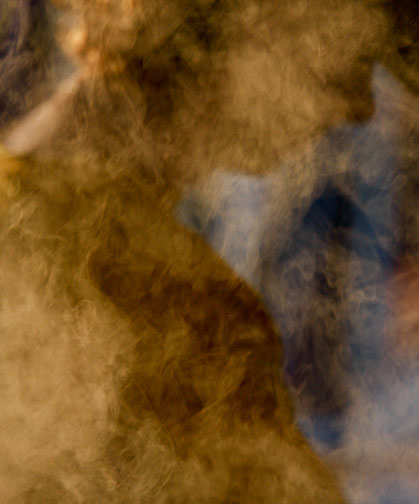
Grilling – Toronto, September 2007
Canon 40D with 70-300mm DO lens @ ISO 400
________________________________________________________________
What About The Nikon D300?
No product exists in a vacume, and so when Nikon introduced the D300 just 3 days after Canon announced the 40D, it’s inevitable that comparisons will be made. Of course since the D300 won’t become available until November any comparison at this point will simply be feature to feature, with image quality difference to be determined down the road.
Price is the first factor to be considered. The MSLP on the 40D is US $1,300 while the D300 is US $1,800, a five hundred dollar differential. For that difference what one gets is roughly the same shooting speed (up to 8FPS with a booster pack), a 12MP sensor vs the Canon’s 10MP, and a similarly weather resistant body as well as 14 bit recording.
Dust removal and Live View are offered, and the Live View trumps that on the Canon by providing autofocus capability. (Performance still to be seen).
A large (very high resolution) LCD screen is provided, and interestingly, Nikon’s top-of-the-line 51 point autofocus system, putting Canon’s 9 point system on the 40D to shame, at least in terms of specs if not actual performance, which remains to be seen.
Even though I have been using Canon cameras for the past 8 years ( a 1V and then my first DSLR, the D30 in 2001) I was a Nikon user for the previous 30 years and have to say that I have always regarded the ergonomics and feature set of Nikons to be highly desirable. But Canon has, in my view, had an edge when it comes to digital image quality, and that combined with Full Frame availability and IS lenses (though Nikon has now caught up here as well) was enough for me to switch in the late 90’s.
The game has now changed. With the just-introduced full-frame Nikon D3 that company has now broken Canon’s monopoly in this market segment. For the past year the D200 has been putting great pressure on Canon in the mid-market, and now the D300 appears to really be set to challenge Canon’s newest prosumer offering, the 40D.
Yes, the Nikon’s price is higher, but specs wise, at least, the D300 appears to offer some real extra value for the additional costs. Assuming two things, that there will be a higher resolution full frame D3 within the next 6-9 months, and that the new Nikons deliver on image quality, then Canon’s almost free run of the past half decade may be coming to an end. Nikon looks to be roaring back with a vengeance.
The question that photographers will be debating on the forums ad-nausium is whether or not to switch, or simpler than that, which camera to buy if just getting into the market for a mid-range DSLR. Of course there’s no easy answer. Photographers with large investments in Canon lenses will likely stay put, as Nikon’s possible advantages with the D300 are probably not compelling enough to make wholesale switching worthwhile.
New purchasers would be well advised to visit a camera store and actually handle both cameras once the D300 ships. All of the pixel peeping that goes on on the discussion forums tells one little about what a camera really is like in use. Only handling the camera, looking through the viewfinder, taking some frames, and carefully judging the ergonomics can do that. How a camera fits ones hands and shooting habits – these are what will ultimately be more important than a heated discussion about a bit of noise one way or another in a 100% blow-up of an ISO 1600 frame of some credless poster’s cat.
All of that aside, Canon finally has some very credible competition from Nikon in almost every segment of the DSLR market, and the D300 and 40D are going to be fighting it out in the months ahead in what looks to be a major punch-up.
________________________________________________________________
Shooting JPG
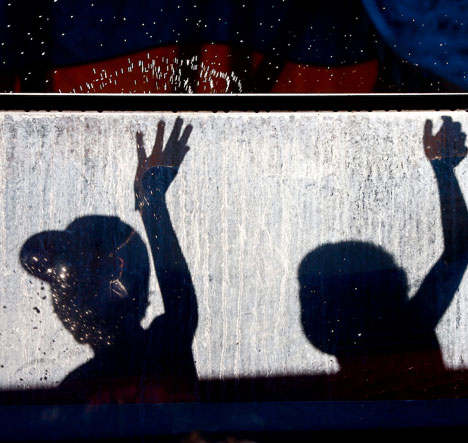
Waves – Toronto, September, 2007
Canon 40D with 70-300mm DO lens @ ISO 400
I usually only shoot raw, but a half hour spent with the latest version of Canon’s DPP software when I first got the camera showed me that I was not going to be happy working with DPP. Image quality from DPP isn’t the issue. It’s fine. Indeed it may be as good as it gets. But the workflow is primitive compared to Camera Raw, Lightroom or Capture One. So, I decided to shoot combined raw + Fine Large JPG, just in case.
Interestingly, though I left the in-camera JPGs at the default settings I found that they produced highly usable files. Tonal rendition, saturation and sharpening were all pretty much dead on and very close to what I could produce with DPP unless the image was technically problematic.
I was fortunate to have a pre-release of one of my preferred raw processing programs (coming soon) that has support for the 40D. I used these to process my raw files.
________________________________________________________________
Image Quality & Conclusion
Long time readers know that I used to do formal testing using the DxO Optics testing system, the same one used byPopular PhotographyandChasseur D’Imagemagazines, among others. I was a beta tester for that system a number of years ago.
But I stopped using it because I found that I didn’t have the time to do lengthy formal tests, and also because there are several web sites that meet the needs of people who like long lists of feature specs, and tables and charts showing the minutia of performance. In the end I found that simply doing some extensive shooting under a variety of conditions was sufficient for me to determine what I needed to know about a camera or lens’ image quality.
My time with the 40D was short, but I found that shooting about a thousand frames over a long weekend was all I needed to be able to draw some preliminary conclusions. These are, in brief, that the image quality of the 40D is excellent, continuing the industry-leading results that Canon has offered for the past 5-6 years. I didn’t see any breakthrough in low noise at the highest ISOs, but as with the EOS 5D ISO 400 is essentially noiseless and can be used as an everyday speed. Noise doesn’t really become an issue until ISO 1600 and even then isn’t that objectionable.
I’m sure that once the major camera testing sites have done their thing there will be lots of charts and graphs to validate this perspective, so if these turn your crank, wait for them. In the meantime, I find that the IQ of the 40D is on a par if not even slightly better than that of the Canon 5D, which up until now has been my benchmark for DSLR image quality both at low and at high ISO.
The bottom line is that the Canon 40D is the most DSLR for the money that Canon has ever offered. Certainly in its price range there doesn’t seem to be anything that can touch it. Move up a notch in price though and the forthcoming Nikon D300 may well put the squeeze on Canon’s hegemony in the DSLR marketplace. Time will tell, and no matter what happens we’ll all benefit from the renewed competition.
September, 2007
________________________________________________________________
The Canon 40D is Available Through B&H Photo
________________________________________________________________
UPDATE
As sometimes happens, something that I write in all innocence is challenged by those who say it simply can’t be so. In this case it’s my claim, above, that "…the IQ of the 40D is on a par if not even slightly better than that of the Canon 5D". Several emails arrived right after publication challenging this claim. The fact that these people may not yet have had an opportunity to try a 40D for themselves (and may not even own or have shot with a 5D) has nothing to do with it. Their sacred cow has been pricked.
Canon 40D with 70-300mm DO lens @ ISO 800
1/320 sec @ f/7.1
So, just for the fun of it, here is a candid portrait of a woman taken at ISO 800. The rest of the shooting specs are shown. This web version has not had any noise reduction applied. If you want to see a section at 100% magnificationclick hereor on the small version above. This is exemplary high ISO performance.
________________________________________________________________
UPDATE
September 10, 2007 – More on Canon 40D IQ
There is an axiom among web and print magazine reviewers that as soon as a new camera review appears there will be a flurry of postings on one of the better known discussion boards that has brand specific forums that decry the writers findings.Oh no! It can’t be! That’s not right. What an idiot! My uncle’s best friend says it’s not true. My cat pictures prove that he’s wrong.
Of course the fact that they may not have ever even held the camera in question, let alone shot with it is beside the point. The fact that they’ve been doing photography since last Wednesday, and the reviewer has been at it for nearly a half century counts for naught. If their sacred cow is being gored (sorry for the mixed metaphor) facts and experience don’t matter. Also, until the patron saint of digital camera testing (you know who he is) has blessed a camera with his charts and graphs the pixel-peepers won’t tolerate dissention.
Such was the case with the above review. I was vilified online for claiming that the Canon 40D had overall IQ (Image Quality) comparable to that of the 5D. And since my commentary appeared online before any other well known equipment reviewer or pundit had an opportunity to do any testing, theChicken Littlesenjoyed a field day.
Today the highly respected photographer and photographic educatorMiles Hecker, has publisheda brief review on his web siteshowing examples of the IQ differences between the 20D, 5D and the new 40D. His results and conclusions closely parallel mine (gee, I’m so surprised).
Maybe the sky is falling after all.
________________________________________________________________
UPDATE
September 21, 2007 – Comments from Knowledgable Users
The 40D is now in wide distribution and so people are able to see for themselves how the IQ of this camera compares to that of the 5D. Many on some forums were annoyed (to put it midly) that I had the gall to say that the image quality was comparable. Well, it’s turned out that I’m not alone in this opinion.
"BTW just purchased a Canon 40D and have begun to experiment with it. Experience has been limited to this point, but so far I concur completely with your analysis of IQ. It’s interesting, isn’t it, that so many individuals out there want to believe that the state of the art in digital imaging equipment exists somewhere in the recent past and are incredulous that something new could be better than last year’s best".
– A well known professional photographer with more than 30 photo books to his credit.
"I have used Canon 5D since it came out on the market and now I have used Canon 40D for a few weeks (and a few thousands of images). I have made some simple tests to compare IQ and as far as I can see you are quite correct – there is no difference between the two in IQ as far as I can see.
As a wildlife photographer I’m very pleased with the speed of 40D especially right now with the rutting season for red deer. I often have
to use ISO 1600 and the noise is not worse than 5D".– A professional Swedish wildlife photographer
You May Also Enjoy...
Light,Land,Life&Magic
by Miles Hecker Publishers Note: This is an old article by Miles. Many or all the links most likely don't work. Miles passed away a
Digital-Contacts
1-2-3 Contact There has been a resurgence in interest by photographers of all stripes in working in Black and White. I attribute this to the
